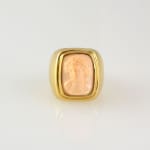Classical Revival Coral Cameo Depicting a Goddess, 18th Century CE - 19th Century CE
Coral and Gold
FJ.6893
Cutting in cameo is an ancient craft, with its origins deep in history. Each cameo is a work of miniature sculptural art, cherished by collectors since the fourth century B.C....
Cutting in cameo is an ancient craft, with its origins deep in history. Each cameo is a work of miniature sculptural art, cherished by collectors since the fourth century B.C. Their original purpose is lost in the mists of time, however their roots extends back over 17,000 years ago to the earliest stone engraving on rocks called petroglyphs. With the discovery of Pompeii in the middle of the 18th century, interest in cameos were renewed, eventually growing into a trend popularized by the stunning collections of Queen Elizabeth and Catherine the Great. By the Victorian era, no proper refined woman was without her cameo broach.
With the discoveries of archaeological sites in Egypt and Italy, interest in the Classics was renewed during the 18th and 19th centuries, a period known as the Classical Revival. This interest swept through Europe and over the years, ancient art forms were brought back and the forgotten skills were slowly relearned. This cameo is a testament to the era’s fascination with the past. Perhaps the Classical Revival also reveals a latent longing towards the Arcadian lifestyles of yesterday abandoned as Europe became rapidly industrialized and increasingly urbanized. The vibrant luminosity of the gold setting perfectly complements the soft pink hue of the coral cameo. This gorgeous ring, itself a product of two different eras, the Classical Revival period and our own, recalls the beautiful jewelry of antiquity that symbolized the wealth and luxury of the Ancient Greece and Rome.
With the discoveries of archaeological sites in Egypt and Italy, interest in the Classics was renewed during the 18th and 19th centuries, a period known as the Classical Revival. This interest swept through Europe and over the years, ancient art forms were brought back and the forgotten skills were slowly relearned. This cameo is a testament to the era’s fascination with the past. Perhaps the Classical Revival also reveals a latent longing towards the Arcadian lifestyles of yesterday abandoned as Europe became rapidly industrialized and increasingly urbanized. The vibrant luminosity of the gold setting perfectly complements the soft pink hue of the coral cameo. This gorgeous ring, itself a product of two different eras, the Classical Revival period and our own, recalls the beautiful jewelry of antiquity that symbolized the wealth and luxury of the Ancient Greece and Rome.



